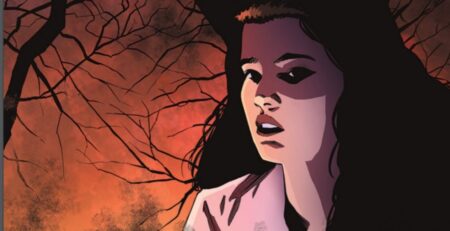
There aren’t many books like Mycelium Seep Vol. 1-3. Published by Markosia, this graphic novel is written and illustrated by Nir Levie, while Dekel Oved provides the English translation. Mycelium Seep Vol 1-3 takes place in two different worlds. One is a near future where an advanced automotive company develops an invention they believe will change the world; solar-powered cars that can be controlled with only a driver’s mind. Working on this project is a vehicle designer named Laura.
The other world is not nearly as similar to our own. The surface of this world belongs to a species of hyper-muscular humanoid creatures. Surrounded by a forest of colossal fungi, these creatures run ceaselessly across the surface, tearing apart any human they see. To stay alive, humanity lives underground, spread across a vast network of subterranean tunnels. Here beneath the ground humanity’s only source of food are giant fungal roots that stretch all the way to the surface. Living in this world we have a young boy named Khalek.
For reasons neither understand, Laura and Khalek’s consciousnesses suddenly merge across space and time into a single mind. This mind experiences both worlds equally, simultaneously controlling both bodies with as a single sentient being. The melding of Laura and Khalek sets in motion a chain of events that threaten to change the shape of both worlds forever.
It’s hard to describe just how ambitious this book is. Mycelium Seep Vol 1-3 can only be described as a work of high concept science fiction. Every page is intricately illustrated, with Levie capturing the surreal architecture of his worlds in exquisite detail. The concepts and imagery on display are unique and speak to the power of a singular vision. And that vision is utterly bizarre, a nightmare world of shared consciousness, fungus and automobiles, Mycelium Seep Vol 1-3 will have you reeling from the first page. At their best, Levie illustrations call to mind the stranger works of psychotropic artist like Phillipe Druillet and Moebius.
What holds Mycelium Seep Vol 1-3 art back though is how disorienting it can be. Levie represents his characters’ shared consciousness via complex, dual point of view shots. In these panels we peer through both characters perspectives at the same time, their views merging together in the middle. They’re strikingly off-kilter but those panels are just the tip of the iceberg.
Almost every single panel of Mycelium Seep Vol 1-3‘s appears on the page as POV shots, with characters’ hands or feet visible in frame. At first we only see through Khalek and Laura’s eyes, but as the comic progresses Levie opens Mycelium Seep‘s camera to even more characters.
With such a large pool of perspectives, it becomes a challenge just sussing out whose eyes we’re seeing through. Perspective shifts between characters can happen at any time and anywhere. Often Mycelium Seep Vol 1-3 shifts character point of view multiple times on a single page. This chaotic style forces readers to re-contextualize the perspective of every new panel. Just trying to keep up with even mundane scenes left me feeling whiplash from panel to panel.
The sheer force of imagination on display in Mycelium Seep Vol 1-3 is remarkable. Each scene progresses with a hallucinatory edge. It asks readers to share its fugue state and plunges them into a fungal fever dream. While it’s certainly to be applauded for its ambition, much of what Mycelium Seep Vol 1-3 has to say is lost in its labyrinthian panels. The artwork is stunning, but it defies comprehension. For these reasons, I can’t say I personally enjoyed this book. Overall, I found Mycelium Seep Vol 1-3 a jarring experience.
Mycelium Seep, Vol. 1-3
TL;DR
The sheer force of imagination on display in Mycelium Seep Vol 1-3 is remarkable. Each scene progresses with a hallucinatory edge. It asks readers to share its fugue state and plunges them into a fungal fever dream.






